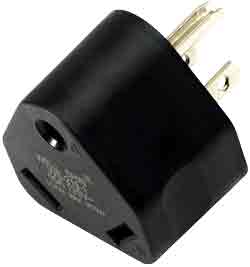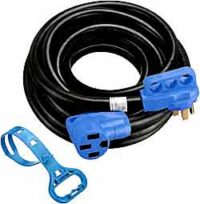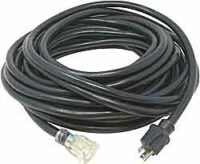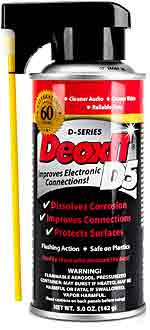All About RV Shore Power, Surge Protectors, 50 amp, 30 amp Hookups
Whether you’re an RVer or a tiny house-dweller, you need to understand the basics of electrical hookups before connecting to any external system. The term “shore power” originally meant the process of providing electrical power from the shore to a boat or ship. Now “shore power” also refers to RV park pedestals where the user can be presented with several options in terms of connections and amperage.
On this page you’ll find easy-to-understand explanations of what you see and what you can expect from it, as well as what you need and how to get it.
In addition, we will explain how to protect your sensitive electronics and appliances against glitches, spikes, power surges, and under-voltage situations.
Connecting your RV, travel trailer, tiny home, or houseboat to an aging “shore power” electrical system can be risky and confusing. Here is what you need to know to connect like a pro.
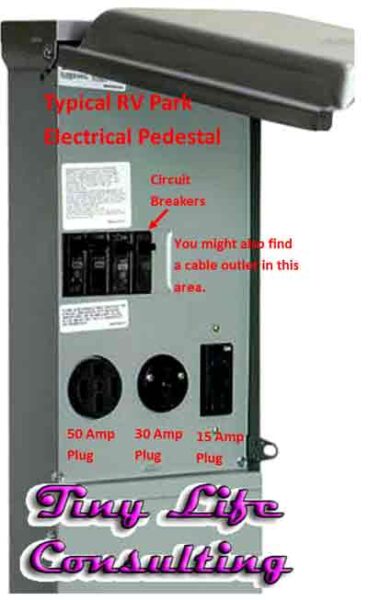
The RV Park Pedestal
When connecting to “shore power” in an RV park, you will be presented with an electrical pedestal that looks like this picture.
There is a 50 amp plug, a 30 amp plug, and sometimes a regular AC outlet like you’d find in your house (15 amp max).
Each outlet has a circuit breaker above it. You usually need to turn this breaker on. It doesn’t matter if they are all on. You’ll be drawing power only from the outlet you plug into.
RV parks generally charge you for which outlet you use. They will charge you more for the 50 amp service because your rig will probably be using more power than one wired with a 30 amp plug.
The 50 amp outlet can supply both 110 volts and 240 volts
Many large RVs and travel trailers are wired with the 50 amp shore power plug. You actually get two 50 amp, 110 volts feeds, called legs. 12,000 total watts is available. This allows you to use many of your appliances at once. The air-conditioner(s) is the main power guzzler, next is an electric clothes dryer, then the microwave oven.
Occasionally, in some higher-end rigs, some appliances, particularly an electric clothes dryer, air-conditioner, and an electric oven, will use 240 volts. The 50 amp plug supplies that too. Using the higher voltage allows them to pull less amperage. 
The 50 amp outlet will supply up to 50 amps (6000 watts) on two two separate circuits before the circuit breaker trips.
Your circuit breaker box will have some appliances wired to one 50 amp leg and some to the other leg.
Click on image to see great YouTube® video explanation.
Appliance wattage ratings
Most appliances are rated in wattage needed (just to confuse us I guess). Converting watts to amps can be done using the power formula, which states that I = P ÷ E, where P is power measured in watts, I is current measured in amps, and E is voltage measured in volts. This means that the current I in amps is equal to the power P in watts divided by the voltage V in volts.
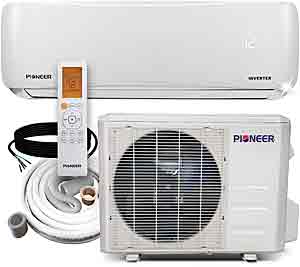
The smallest RV air -conditioner (7000 BTU) can pull 14.40 amps as it starts up and then cruises at about 7.5 amp. Air-conditioners are available up to 15,000 BTU. They draw almost 30 amps on startup and run at about 13 amps after that. Many larger rigs have two air conditioners on the roof.
- An electric clothes dryer can use 24 amps at 240 volts. That’s a lot of power.
- Electric coffee maker about 15 amps.
- Electronics use very little power.
As an example, this DELLA Mini Split Air-Conditioner Heater Ductless Inverter System supplies 9,000 BTU of cold air and is one of the few that runs on standard house current. It requires about 7.5 amps. Currently priced at $693.46 from Amazon. See more Mini/Split heat pumps on this page.
Why do you need to know how much current you are drawing?
If you pull into an RV park with limited shore power connect-ability or a friend’s driveway with a standard house outlet, you’ll need to decide which appliances you can run so you don’t overwhelm the circuit and trip the breaker.
If you need to replace your generator or add solar panels, you’ll need to know how much current you’ll need to make for the appliances you may want to use at the same time.
See this page for more information: Running RV Appliances Like Air Conditioners Off-Grid
Using Extension Cords and Adapters (shown above)
If your tiny home or RV only has a 50 amp shore power cord and you find yourself in a park with only 30 amp service, you may need to adapt your power cord plug to the smaller outlet. This is fine as long as you understand the limitations.
If you plug your 50 amp shore power cord into a 30 amp outlet, your 240 volt appliances will not work. If you draw more than 30 amps the circuit breaker will trip. This will not damage anything but you’ll need to reset the circuit breaker.
I recommend NOT making your own adapters as this is where people run into trouble by connecting things that should not be connected. Using pre-made adapters will avoid that.
- Never plug your 50 Amp RV plug into your homes clothes dryer outlet. The plug is similar but the ground pin is different so it should not fit. They are not wired the same.
- If you have a 50-amp outlet added to the outside of your home to plug your RV into, make sure the electrician is aware that the outlet is not wired the same as an ordinary 240 volt outlet. Making a mistake here could do real damage to the appliances and electronics in the RV.
- The reason we say this is in response to almost weekly Facebook posts from RV owners who have plugged their 110 volt RVs into a 220 volt outlet and caused catastrophic damage to most of their appliances and the power center. The white “neutral” wire (see diagram) needs to be installed to create two 110 volts “legs.”
30 amp to 15 amp RV Shore Power Adapter
Most of us have a 15 amp AC outlet on the outside of our homes. This adapter changes a 30 amp RV connector to a regular house outlet. I plug in my RV the night before we leave on a trip so the batteries get charged and the refrigerator gets cold. We can also run the air-conditioner for short periods. There is no harm in using this adapter. Every RV owner should have one.
50 amp to 15 amp RV Shore Power Adapter
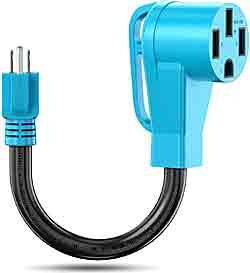
This 50 to 15 amp RV Shore Power adapter, called a dog-bone, allows bigger rigs to be plugged in to a standard household outlet. Again, there is no harm in using this adapter. You just need to be careful about how many appliances you run at one time. Your refrigerator, and then maybe one air-conditioner.
There are some compatibility issues you need to be aware of. The manufacturer’s description says, “Please check your connections and ensure they are compatible with the following: NEMA 5-15 to SS2-50R, prior to purchase of this item.”
These also have a tendency to pop the GFI outlets.
Your 240 volt appliances like the clothes dryer will not work while plugged in this way.
If the circuit breaker in the house trips, you’ll need to turn off some appliances to reduce the current draw.
See the 50 Amp AC outlet in the right column that you could have hard-wired into your home to supply full power to your rig.
Getting More Power from the Shore Power Pedestal
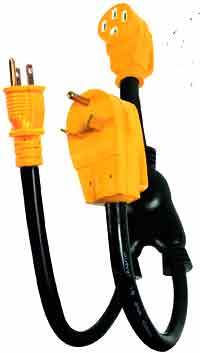
Many times, especially in the winter months, you might need more power than the 30 amp outlet will give you. You can run a heavy -duty extension cord from the 20 amp outlet to power a space heater. Visit this page for more information.
Unique Adapter Combines Power
Here’s a unique RV Shore Power adapter that lets you combine the 15 and 30 amp outlets of the pedestal to supply 45 amps to your RV if no 50-amp service is available.
It draws the combined power from a 15 and 30 AMP outlet, which allows the RV to receive up to 45 amps. This maximizer does not work when plugged into GFI type outlets. You’ll get 30 amps to half of your circuits and 15 amps to the other half of the circuits so it takes some getting used to.
This adapter is also useful if a homeowner has previously installed a 30-amp outlet for a travel trailer, then get a larger travel trailer that has a 50 amp plug. In this case you can plug the 30 amp plug into the 30 amp outlet and run an extension cord to a basic 15 amp outlet nearby.
Using the right extension cord is extremely important
If you use an extension cord, it needs to be heavy-duty enough to handle the load you’ll be drawing. Those “heavy-duty” orange hardware store extension cords will not do. You must use the extension cords shown below.
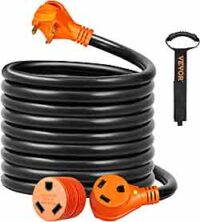
This 10 gauge, 25′ extension cord comes with 30 amp RV plugs. It includes a 15 amp adapter to fit a stadard electrical outlet.
The danger of using too light of an RV Shore Power extension cord
If you use an extension cord that is too small of a gauge for the current you will be drawing, the cord and connectors 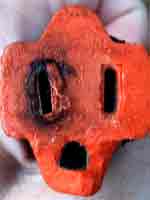 will get hot, could melt, and start a fire. The wiring inside the walls of your house will also be getting hot.
will get hot, could melt, and start a fire. The wiring inside the walls of your house will also be getting hot.
In addition, using a small extension cord causes a large voltage drop. This can damage your appliances and electronics. These low-voltage conditions (brown-outs) are more often the cause of damage than voltage spikes.
Use an extension cord that is at least 10 gauge like those shown above.
Keep the contacts shiny clean on your RV shore power extension cord
Use steel wool to clean your male extension cord contacts. For the female end (shown in photo) make sure it’s unplugged and spray with a little contact cleaner. Work the male prongs in and out to rub the corrosion loose. Use paper towel to clean off loose corrosion that comes out onto the plug. Spray a bit more contact cleaner into the openings then shake off the access. If the contacts feel loose replace the plug or entire cord.
See my blog post about corroded plugs and how to clean them before they melt: Melted RV Shore Power Plug How to Avoid Tragedy
Surge Protectors
A surge is too much voltage coming thru your wiring. Surges usually last for micro-seconds and don’t usually cause catastrophic damage. Power surge damage is cumulative, causing electronic components to weaken over time.
Internal voltage spikes & “brown-outs“
Devices with motors that turn on and off, like your air conditioner, can cause internal spikes and brown-outs. Turning on and off your blow dryer can also cause small spikes. Adding surge protectors to each device offers protection and extends the life of your electronics.
When you read the specifications on a surge protector, you will see how many joules it can absorb. Once the tiny device inside it has absorbed that many joules it stops protecting. Hardware store brands will activate and stop spikes at 330 volts or 400 volts or 500 volts. You want a surge protector with the highest amount of joules, and lowest “clamping voltage.” See the widget section of this page for my favorite surge protectors.
Putting a surge protector on your main connecting cord will not prevent these “internal” power surges.
Click this link for more about surge protectors and Uninterruptible Power Supplies .
External voltage spikes
 Dangerous voltage spikes can enter your RV, travel trailer, or tiny home thru your electrical wiring, telephone wiring, and/or TV cable. Voltage surges can be cause by the power company, nearby industry, and lightning (among other things).
Dangerous voltage spikes can enter your RV, travel trailer, or tiny home thru your electrical wiring, telephone wiring, and/or TV cable. Voltage surges can be cause by the power company, nearby industry, and lightning (among other things).
RV parks are notorious for having “dirty” shore power
Over time, moisture has seeped into the wiring and corrosion has layered the outlet connections. Older parks’ electrical infrastructure was not designed to handle today’s power needs. Power fluctuations are rampant. Corroded outlets cause tiny sparking. The sparking noise creates havoc with sensitive electronics. This is why an external surge protector is recommended.
The Southwire Surge Guard shown here is considered the best by many. There is a 30 amp version. It includes an anti-theft lock ring on the cord, multi-mode surge protection, commercial-grade brass receptacle, and an automatic reset on power restoration.
Check the power with the readout on the surge protector
Plug in your surge protector and look at the readout to see if everything is OK with the pedestal power. Then plug in the cord to your RV.
Lock that puppy up
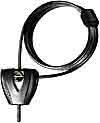 Tip: Get a chain and lock and lock it securely to the pedestal so it doesn’t get stolen. A Python locking cable can tighten around the surge protector and power pedestal so the surge protector can’t be slipped out. Surge protectors are stolen regularly.
Tip: Get a chain and lock and lock it securely to the pedestal so it doesn’t get stolen. A Python locking cable can tighten around the surge protector and power pedestal so the surge protector can’t be slipped out. Surge protectors are stolen regularly.
Hard-wired surge protector
A surge protector can also be installed into your main connecting block to offer the same protection. The advantage is that it is always connected and can’t be stolen. However, if you have a 50-amp system, you might need two to cover both 50 amp legs.
You are Paying for More Than Just Simple Surge Protection
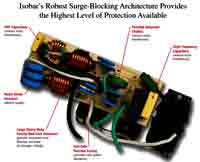
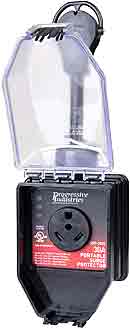
Take a look at the surge protector components shown on the right. The three little blue discs in the left corner are what stop the surge voltage. They cost $2.50 each. So what else do you get for the huge amount of money an RV surge protector can cost?
Mostly you are paying for the heavy duty container it’s in. Most of the other components filter noise off the power line.
In many cases you are paying for a line-fault tester with a very fancy WiFi app that tells you the current condition of the voltage coming in. Not actual protection.
Some surge protectors include an insurance policy that covers damaged equipment IF you have the necessary backup documents (see below for more).
The 30 amp surge protector on the left is just $47.77*. It does a very good job of stopping harmful voltages. It also has a Open Ground, Open Neutral & Reverse Polarity Detection, Mis-wired Pedestal Indication, and Surge Failure Indicator.
Hughes Autoformers PWD50EPO Power Watchdog Smart Surge Protector
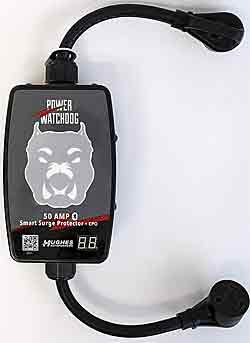
The 50 amp Power Watchdog Smart Surge Protector + EPO (emergency power off) offers a powerful 4,800 Joules of advanced surge protection for your coach. Their Patented Power Watchdog + EPO is the world’s first smart surge guard and surge protector with built-in Bluetooth connectivity so you can monitor live park power conditions on your smartphone in real time! Get text alerts of dangers before something catastrophic happens. The new EPO (emergency power off) units will automatically SHUT DOWN power if there are dangerous conditions of too high or low voltage, open ground or open neutral as well as more. Unit automatically shuts down power if voltage drops below 104 V or over 132 V. Once power conditions are good and stable for 90 seconds, the unit will turn back on automatically.
These are expensive ($339.99* last I checked) but the cool thing is they have a replaceable surge protection section for about $38.00*
Nothing Stops Lightning
A lightning bolt is millions of volts. Nothing can stop that. It can hit power wires miles away and still damage your electrical equipment. That’s where the insurance comes in.
Most surge protectors come with insurance policies. For these to pay. you need have a list of everything connected to an outlet in your house or RV. Write it down: Make, Model, Serial number. Take pictures of your equipment plugged into the outlets. Mail in the surge protectors registration postcard. They do pay.
The best way to protect your electronics in a lightning storm is to unplug your devices.
Softstarts
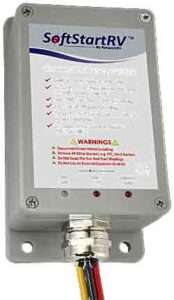
When an appliance first turns on there can be a large current draw and the circuits power up or mechanical parts like compressors of the air conditioner get going. These huge current draws can be hard on the rest of the electronics in your rig by causing low voltage situation and then voltage spikes.
SoftStartRV provides an effective solution in the reduction of startup current, typically up to 70%, but still provides full startup torque for compressors and motors.
A Softstart allows you to run two air conditioners on a 30 amp circuit without popping the circuit breaker. A Softstart device needs to be wired to each air conditioner. The company provides step-by-step phone consultation as you install it so you get it wired properly.
SoftStartUp
The SoftStartUp is basically the same device as the SoftStartRV but instead of installing it in each air conditioner you plug it in at the parks electrical pedestal. This save you from having to climb on the roof or hiring someone to do the installation. It can be used with your surge protector.
SoftStart products do not create more power, they optimize the power you have to end tripping circuit breakers. It includes all 30 and 50 amp adapters that might be needed.
SoftStart may not be compatible with all other devices in your RV. Air conditioners and dehumidifiers that use digital controls and certain types of brushless motors are not compatible with the SoftStart process. Variable speed, inverter air conditioners are not compatible.
More pages of the Tiny Life Consulting website you’ll be interested in
Learn more about generators and inverters at the bottom of this page: TV Reception for a Tiny House or RV
See the chart on this page to learn what your appliances power draw is: Running RV Appliances Like Air Conditioners Off-Grid
Generators or Portable Power Centers: Which One is Right for You?
Portable Power Centers How To Choose



